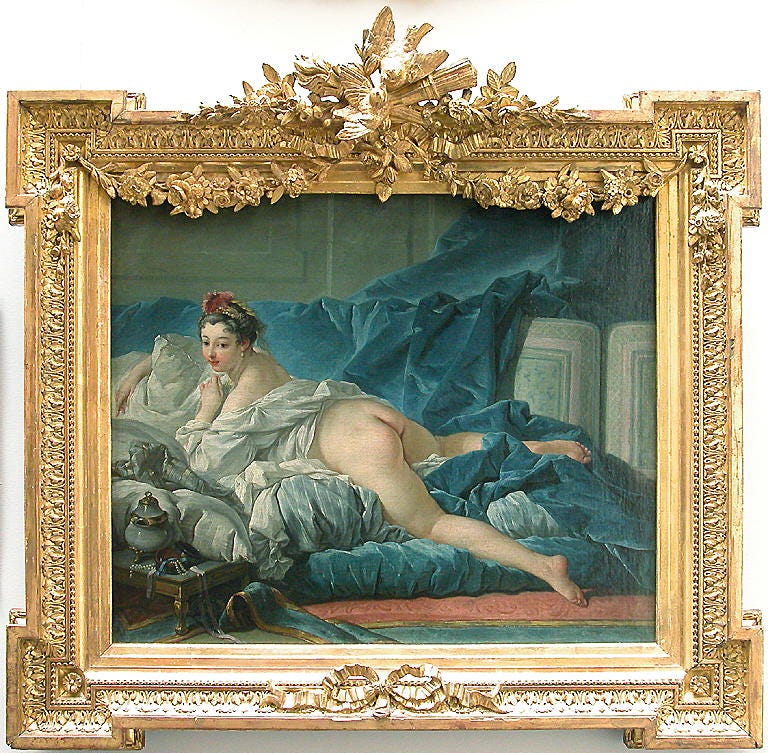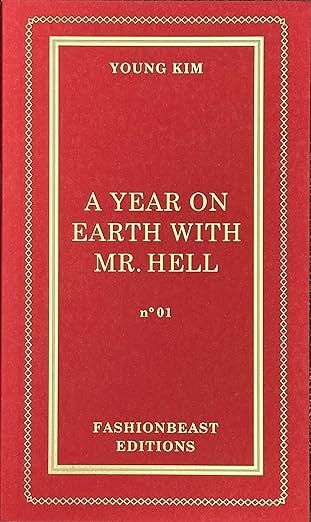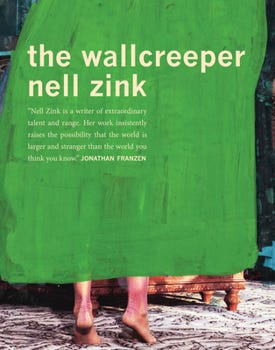Books I Sell #001
A decadent memoir, the novel I've sold the most this year, and a mother's transformation

It’s the high-octane yellow titles beaming across images of women feeling decadent, ravished, or simply coquette that hints at the feminine pursuit of pleasure within.
I’m Mostly Here to Enjoy Myself by Glynnis MacNicol
Transfixed by the François Boucher painting on the cover, I knew the MacNicol was for me at first sight.
This painting stopped me in my tracks this summer at the Louvre. It’s said that the woman in the painting is Boucher’s wife. I love imagining their relationship. As a former artist model, I could feel into the utter coyness and sweetness of this pose. It’s in the spread of her legs. That pose is what part of this book feels like.
In I’m Mostly Here to Enjoy Myself, MacNicol sends herself to Paris for the month of August, her summer tradition, touch-starved and arriving to the banquet of a Parisian dating app called Fruitz. The balance of this book is the way she embodies both forms of odalisque and flâneur.
This memoir is drenched in decadence and studded with twenty-seven-year-old French men.
Enjoying and being enjoyed, skin to skin, she feasts on the pleasures offered to her. Lounging in grassy parks, butter on fresh bread, eager-to-please men. Walking through neighborhoods once inhabited by women like her… from Edith Wharton’s house during her Parisian affair where she wrote erotica1 to actress Romy Schneider’s house (of film La Piscine). MacNicol examines what it has been like to be a financially independent creative woman in the past and today. Unmarried and childless, she has different freedoms than other women.
“I am untethered. Or if not exactly that, then my tethers have the capacity to unfurl at great lengths without ever breaking.”
Further reading
If you want another memoir with a good dose of eroticism, look for My Year on Earth with Mr. Hell by Young Kim. I was buying books for the shop from an arts writer and this small-press little red cover with gold foil printing intrigued me.
I read it on my next two lunch breaks and sold it to an intrigued mom from my staff pick shelf. The book started as Young Kim’s diary about her affair with punk rocker Richard Hell at his request and later his chagrin when she decided to publish it. Hell, who is known for his own erotic writing, didn’t want his chronic infidelity to be made public. For Kim the affair was an enlivening experience within her grief after the loss of her longtime partner Malcolm McLaren (creator of the Sex Pistols and father of punk style with his then-partner Vivienne Westwood).
With her proximity to punk sensibility and her cosmopolitan life, this memoir gives high glamour.
Critic Greil Marcus described it as “The most graphically effective sex writing I've read in a long time. The same material as fiction wouldn't have such an immediate and even threatening effect: when someone is making something up, that gives the reader an out, and this doesn't.”
Big Swiss by Jen Beagin
Greta enters into an affair with a woman whose sex therapy sessions she transcribes for Hudson Valley’s unlicensed sex therapist, known as OM (Ojai vibes). Great premise and Beagin delivers.
This is the novel I’ve sold the most this year.
Because this is a very plot-driven novel, I’m not going to get into it too deeply as I want to leave it to be discovered by you. I will say that there’s a series in development currently that has Jodie Comer cast as Big Swiss.
Talking with a customer the other day who came back to buy a copy to give her sister, we were remarking that the book has a lot of humor, but also sustained emotional stakes. It’s funny and real. We agreed that it could be called a beach-read-meets-literary-fiction. It has the best of both worlds.
Further reading
It made me feel a similar way a novel I read ten years ago. The Wall Creeper by Nell Zink.
Zink worked as a transcriptionist, like Big Swiss’s Greta. She sold the book on the strength of sassy letter she wrote to Franzen. I was very enthusiastic about Zink when I was 19 at Bart’s. I’m curious what I would think of it re-reading it ten years later, but the elements that brought it to mind while reading Big Swiss are its funniness at the line level, its velocity of plotting, and the giddiness of an affair.
A Woman’s Battles and Transformations by Édouard Louis
For Louis, a photograph of his mother as a girl is arresting in its irreconcilable portrait of his parent. Uncanny to see her happy, to see her open, to see her even be a bit flirtatious. The NYT feature on Louis is headlined “I Always Write With a Sense of Shame” and that’s certainly present in this book.
“Seeing the photo reminded me that those twenty years of devastation were not anything natural but were the result of external forces – society, masculinity, my father – and that things could have been otherwise,”
There is a lot to do with subjugation, economic vulnerability from pregnancy, and dysfunctional families. AND the amazing transformation, her feminine pursuit of pleasure that puts this book in conversation with the others, is that his mother blooms in middle age. Unrecognizable, with a new lover in Paris, with her hair done up, with make-up, with outfits. She takes her chance at happiness. She grabs it and pulls herself into a new life.
Their relationship changes. She tells him about being out a nightclub as a girl where she met one of her best friends, “a boy like you” meaning a homosexual. Louis had tried to hide his gayness from his family, and in doing so had not allowed her to be his mother in not allowing himself to be known. I read it on a hot, slow afternoon at the shop, on a rare day where we’d priced all the books waiting for us. I will certainly be reading more.
Further reading
Brought further into American readership after her Nobel Prize win in 2022, Annie Ernaux is the obvious godmother to the writing of Edoard Louis. It’s very French to write novels from life. The film Anatomy of a Fall displays this literary tradition. Louis has said of Ernaux “Her books are so powerful because they offer a new image of what crafting a book really means. I have tried to use this question as a starting point in all my writing.”
I read Ernaux’s Getting Lost, her narrative of an affair with a much younger man. I was moved at the man wanting to have a child with menopausal Ernaux, the magical thinking of passion. I agree with Louis, “No one writes in the same way after reading Annie Ernaux.”

Most days of the week I’m at Bart’s Books, chatting about books, and the idea is that this newsletter can spread these conversations further into space and time. I could call this episode My Year of Reading Books About Affairs. I wouldn’t have seen that before placing these books next to each other. That’s one of the things I love about bookselling: the many branching rivers of books, their structures and the resonances they create with themselves and each other.
Beatrice Palmato by Edith Wharton, 1919 Paris











I love this!!